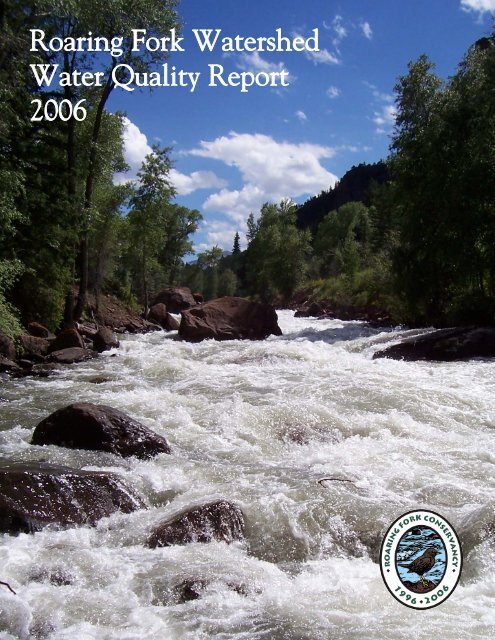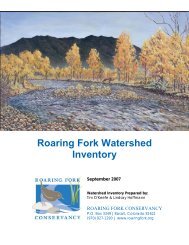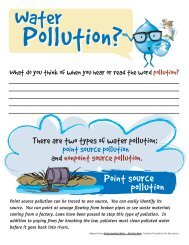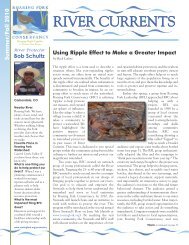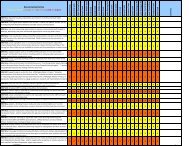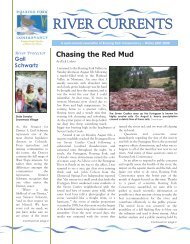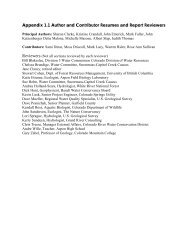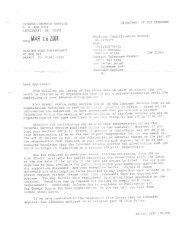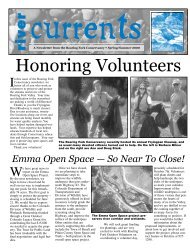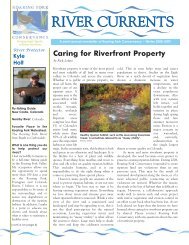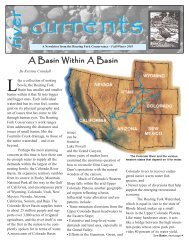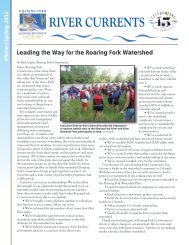2006 Roaring Fork Watershed Water Quality Report
2006 Roaring Fork Watershed Water Quality Report
2006 Roaring Fork Watershed Water Quality Report
- No tags were found...
Create successful ePaper yourself
Turn your PDF publications into a flip-book with our unique Google optimized e-Paper software.
Family Biotic Index (FBI)In a polluted stream, there typically are large numbers of only a fewspecific species, while in a clean stream there is greater diversity ofspecies. Because both pollution sensitive and tolerant forms arepresent in ‘clean’ waters, it is the absence of sensitive species andpresence of tolerant species that may indicate pollutants. The FamilyBiotic Index (FBI), a form of the Biotic Index, is based on groupingmacroinvertebrates into categories depending on their response toorganic pollution (Hilsenhoff, 1988).<strong>Water</strong> <strong>Quality</strong> based on Family Biotic Index(Hilsenhoff, 1977)Biotic Index <strong>Water</strong> quality Degree of organic pollution0.00 - 3.50 Excellent Organic pollution unlikely3.51 - 4.50 Very Good Possible slight organic pollution4.51 - 5.50 Good Some organic pollution probable5.51 - 6.50 Fair Fairly substantial pollution likely6.51 - 7.50 Fairly poor Significant organic pollution7.51 - 8.50 Poor Very substantial organic pollution8.51 - 10.0 Very poor Severe organic pollutionData Collection and AnalysisMost sample sites are monitored on a monthly basiswhile a few streams that have shown consistent highquality are sampled on a quarterly basis. Field parametersare analyzed by the Conservancy and streamteam volunteers while tests for metals, nutrients, andmacroinvertebrates are sent out foranalysis. Field parameters, metals, andnutrient amounts are important inestablishing baselines for analysis andfuture threat assessments. Macroinvertebratedata (sidebar) is important becauseit provides information on the biologicalintegrity of the stretch of water.Macroinvertebrates reflect stream conditionsover a period of time rather thanon the day of sampling.Frequency of water quality testingand the parameters tested are based onstate standards for stream health(CDPHE, 2005) and the significance ofeach parameter (Colorado <strong><strong>Water</strong>shed</strong>Network, 2005). Nutrients are collectedtwice per year and macroinvertebratesare collected only for targeted studies.The chemical, physical, and biologicalparameters sampled by Conservancystaff, volunteers, and schools are asfollows:• Metals analysis: Cadmium,copper, lead, zinc, magnesium,iron, selenium, arsenic,aluminum, calcium, andmanganese (total and dissolvedmetals for allstations).•Nutrient analysis:Nitrate, phosphate,sulfate, chloride, ammonia, and total suspendedsolid concentrations.• Field parameters: Temperature, pH, totalalkalinity as CaCO3, total hardnessas CaCO3, and dissolved oxygen.• Physical assessment: Flow, riparian and instreamhabitat assessments (e.g. bank stability,percent cover, substrate type and size),and river/stream reach assessments.• Biological conditions: Macroinvertebratesare studied to evaluate the ability of water tosupport aquatic life using the FBI.See the Appendix for detailed descriptionsof each water quality monitoringparameter.5
5. Most Common PollutantsAs described in the previous section, theConservancy and River Watch test waterfor a wide range of chemical, biological, andphysical parameters. The following informationfocuses more specifically on theparameters that cause most of the pollutionproblems in the <strong>Roaring</strong> <strong>Fork</strong> <strong><strong>Water</strong>shed</strong>. InColorado, water quality standards exist fordrinking water supply, recreation, agriculture,and aquatic life. The source fortoxicity and state standard information isCDPHE (2005); information on pollutionsources and their effects on water quality istaken from CWN (2005). For more informationon the parameters tested and theirimportance, visit www.roaringfork.org/wqm.MetalsSelenium (Se): Toxic to rainbow trout at 5.0 µg/l.Geology, naturally disturbed soils, and areas of developmentand agriculture all introduce selenium intoour waterways.Aluminum (Al): Occursnaturally and makes upeight percent of earth’ssurface. Low levels ofaluminum are not thoughtto be harmful. Toxicity isaffected by pH levels,staying in dissolved formbelow 6.5 and contaminating fish gills.Lead (Pb): Toxic to aquatic life in the 10-100 µg/lrange. Causes delays in normal physical and mentaldevelopment in babies and young children, probablecarcinogen. Enters environment from industry,mining, plumbing, gasoline, coal, and as wateradditive.Iron (Fe): Precipitates may cover fish spawninghabitat, egg, and macroinvertebrate habitat. Occursnaturally as a mineral from sediment and rocks orfrom mining, industrial waste, and corroding metal.Manganese (Mn): Primarily occurs as mineral fromsediment and rocks and secondarily from pesticides,fertilizers, and livestock feed. Manganese can stainlaundry, affect taste of water, and at high levels istoxic to plants.NutrientsPhosphorous: CDPHE is proposing a state standardof 0.1mg/l for drinking water supply. High concentrationscan lead to algal blooms that reduce the amountof dissolved oxygen available in the water.Sulfates: State drinking water supply standard is 250mg/l. When a combination of sulfur and certainmetals enter a body of water there is a reaction withoxygen that lowers the pH of the water (becomesacidic).Ammonia: State standard for aquatic biota is 20 µg/l.Ammonia is a form of nitrogen combined withoxygen that, in high concentrations, inhibits abilityof fish to excrete their own ammonia waste, leadingto brain damage.Suspended solids• National average for suspended solids is 150 mg/l.• High levels of suspended solids can impair aquaticecosystems by increasing the temperature of thewater, abrading and clogging fish gills, and smotheringplants, insects, and trout spawning beds.pH• State standard of 6.5 - 9.0 for aquatic life and 5.0 -9.0 for drinking water supply.• pH affects what can live and reproduce successfullyin a body of water.• Most aquatic organisms prefer a pH of 6.5 - 8.0.6
6. Importance of Healthy Streams• Drinking water: Rivers and streams are used in 55percent of Colorado’s communities for drinkingwater, with groundwater supplyingthe remaining 45percent (CDPHE,2004). Increasedpollution andsediment loads insurface and groundwater create aneed to increase treatment of drinking water supplies.• Irrigation: Surface water is the primary source ofirrigation water (Perlman, 2005) and if this supply ispolluted, or diminished,agricultureand its productsare affected. In theshort term, irrigationremoveswater fromstreams, but typicallycontributesto return flows and groundwater recharge.• Economic impacts: All of the followingrecreational activities and related economic benefitsdepend on highquality water:A Conservancystudy foundthat fishing andrecreation on theFryingpan Riverand Ruedi Reservoircontributeapproximately $3.9 million per year to the <strong>Roaring</strong><strong>Fork</strong> Valley’s economy (Crandall, 2002).The 2005 year end report of the Colorado RiverOutfitters Association (CROA, 2005) reports thatthe white water rafting industry on the <strong>Roaring</strong> <strong>Fork</strong>River is responsible for over $594,000 in totaleconomic impact, while the Colorado River throughGlenwood Springs boasts an economic impact ofnearly $14 million.Additionally, data compiled by the CDOWshows that hunting and angling contribute over $1.5billion to the state economy and wildlife viewingaccounts for over $940 million (Pickton, Sikorowski,2004). The <strong>Roaring</strong> <strong>Fork</strong> <strong><strong>Water</strong>shed</strong> has 42 continuousmiles of Gold Medal water along the lower Fryingpanand <strong>Roaring</strong> <strong>Fork</strong> rivers.• Wildlife: About 80 percent of Colorado’s wildlifespecies are dependent on our rivers, streams,wetlands, and riparianareas at some point intheir life in order tosurvive and successfullyreproduce. Pollution ofthe valley’s rivers adverselyaffects riparian andaquatic habitat, and thespecies dependent onthem. Recent returns of breeding bald eagles andosprey, high quality great blue heron rookeries, andincreased designation of Gold Medal fisheries areindicators of good riparian habitat and generally highwater quality.• <strong>Quality</strong> of life: Most people who live in or visitthe <strong>Roaring</strong> <strong>Fork</strong> Valley are attracted to the areabecause of its naturalsetting, which contributesto a high quality of living.Healthy streams are thebasis for healthy ecosystemsand provide for agreat diversity of plantand animal species thathelp make the <strong>Roaring</strong><strong>Fork</strong> Valley so unique. There is intrinsic value in protectingthese resources because of the interrelatednessof water to all life.“We enjoyed our short time on the Fryingpan.We only caught a couple fish, but any day fishingis better than working. We also enjoyedwatching a bald eagle roosting in a large treealong the river. Every bald eagle sighting is aspecial and treasured experience.”- Survey participant from the Fryingpan ValleyEconomic Study (Crandall, 2002)7
7. Healthy Stream ReachesHealthy streams are not only important to healthy wildlife populations but are also critical to the valley’seconomic sustainability. Providing clean drinking water, aesthetically pleasing recreational experiences, andsupporting a booming tourism industry, rivers are the life blood of the valley.The <strong>Roaring</strong> <strong>Fork</strong> Conservancy’s water quality data indicate that many reachesof stream in the watershed are in good health and are considered in this report asHealthy Streams. Stream reaches with good water quality typically have notexceeded state standards for any parameters tested, although on occasion a singleparameter may test high. Healthy Stream reaches and water quality sampling sitesthat show good water quality are:<strong>Roaring</strong> <strong>Fork</strong> River at Hooksexcellent riparian habitatDifficult Campground: (<strong>Roaring</strong> <strong>Fork</strong> Riverabove Aspen) within the White RiverNational Forest; no major sources of pollution;Castle Creek: much of basin in pristine condition and within NationalForest; low levels of development; excellent riparian habitat<strong>Roaring</strong> <strong>Fork</strong> River at BasaltGerbaz Bridge: (<strong>Roaring</strong> <strong>Fork</strong> River) the river has increased in volume enough to dissipate the pollution seenin Aspen and along Brush Creek; good riparian habitatMeredith: (Fryingpan River above Ruedi Reservoir) upper reaches are above mostdevelopment; affected only by flow alterations; excellent riparian habitatBaetis Bridge: (Fryingpan River below Ruedi Reservoir) excellent tail-waterfishery with high water quality; altered temperature and flow regimes; goodriparian habitatUpper Basalt/Pueblo Bridge: (FryingpanFryingpan River at Baetis BridgeRiver) continued high quality water to confluencewith <strong>Roaring</strong> <strong>Fork</strong> River; low development densities in Fryingpanbasin, good riparian habitatBasalt/7-11 Bridge: (<strong>Roaring</strong> <strong>Fork</strong> River) increased volume with theaddition of Snowmass/Capitol Creeks creates high water quality; no majorpollution sources in this reach; marginal riparian habitat<strong>Roaring</strong> <strong>Fork</strong> River near WestbankHooks Bridge: (<strong>Roaring</strong> <strong>Fork</strong> River) continued high water quality which is improved by high flows from theFryingpan River; good riparian habitatCrystal River below RedstoneWestbank Bridge: (Lower <strong>Roaring</strong> <strong>Fork</strong>) overall good water quality; like most ofthe <strong>Roaring</strong> <strong>Fork</strong>, occasional high levels of lead and sediment; good riparianhabitatGenter Mine Bridge: (Crystal River below Marble) pristine, free-flowing headwatersbasin with very little development pressure currently; excellent riparianhabitat8
8. Threats to Healthy StreamsPollutionGrowing public awareness and concern for controllingwater pollution led to the enactment ofthe Federal <strong>Water</strong> Pollution Control ActAmendments of 1972. As amended in 1977,this law is known as the Clean <strong>Water</strong> Act(CWA). The Act established the basic structurefor regulating discharges of pollutants intothe waters of the United States. The CWAimposes fines, and remediation efforts areundertaken when violations occur. The CWAalso requires that each metropolitan area in theUnited States prepare a storm water runoffremediation plan. The Conservancy hasworked closely with Aspen, Basalt, andGlenwood Springs to help implement theseplans.Point source pollution has an identifiablesource, such as a pipe dumping waste directlyinto a stream,which makesassessment ofresponsibility relativelyeasy. Inthe <strong>Roaring</strong> <strong>Fork</strong><strong><strong>Water</strong>shed</strong> wherethere is littleindustry, pointsources of pollution are most common from wastewatertreatment facilities.Non-point source pollution (NPS) ismore difficult to track and treat than pointsource pollution and and is the number onesource of pollution in the <strong>Roaring</strong> <strong>Fork</strong> Valley.NPS pollution is not discharged from a singlesource; instead many sources that are spread outover a large area combine to create thisproblem. A large source of NPS pollution in thewatershed is storm water runoff that carriessediment and pollutants from streets andparking lots through storm drains and intovalley streams. Over-fertilization of lawns, golfcourses, and agriculture as well as improperseptic tank construction or maintenance canincrease non-point source pollution, especiallyaffecting groundwater.Flow AlterationThe phrase “the solution to pollution is dilution”sums up the importance of an adequate water supplyfor maintaining high water quality. Low flows intensifypollutant problems and increase sediments thatcan smother trout eggs and aquatic vegetation. TheConservancy’s recently completed Stream FlowSurvey report describes in detail flow alteration in thewatershed (the full report is available at:www.roaringfork.org/publications). The <strong>Roaring</strong> <strong>Fork</strong><strong><strong>Water</strong>shed</strong>’s flows have been, and continue to be,Transbasin Diversions9
Threats to Healthy Streams (cont.)Basalt and Glenwood SpringsThe Conservancy received grants and support fromseveral other entities to conduct storm water assessmentreports for both Basalt (Matrix Group, 2001) andGlenwood Springs (Matrix Group, 2003). Studies showthat a wide range of activities affect these communities’water quality:• construction of buildings, roads and bridges,• filling of the river channel and flood plain,• degradation and removal of natural vegetation,• increased recreational use,• increased residential and commercial constructionand development in riparian habitats, and• a growing number of contributors to non-pointsource pollution runoff.10altered to meet agricultural, municipal, and industrialdemands within and beyond thewatershed boundaries. Aspects ofthe flow regime, including flowmagnitude and timing, duration ofhigh and low flows, and rate ofchange are related to important Twin Lakesbiological and geomorphological Tunnel38,064 AFprocesses that influence overall35%(acre feet)stream health. The Stream FlowSurvey found that much of the significanthydrologic alteration isseasonal, influenced by activitiessuch as irrigated agriculture(summer) and snowmaking(winter). Although alterations from these activitiesStorm water impacts on streams• Stream Hydrology: Impermeable surfaces, such asroads and parking lots, lead to a decrease in rain andsnowmelt infiltration, increasing runoff.• Stream Morphology: widening and erosion due tohydrological changes.• Stream <strong>Water</strong> <strong>Quality</strong>: Increases in turbidity(cloudiness), metals concentrations, temperature,nutrient loads, bacterial contaminants, trash,organic matter, salts, and debris.• Aquatic Ecology: Pollutant loading can significantlyalter aquatic ecology.can be severe (i.e. occur over all months in a season),there is a significant return flow of water to streamsfrom these seasonal uses.Other water uses cause hydrologic alterationthroughout the year, including trans-mountain diversions,Ruedi Reservoir management, and diversion fordomestic water supplies. The trans-mountain diversionsare one hundred percent consumptive. Withabout 80 percent of the state’s water found west of theContinental Divide and 80 percent of its populationeast of the Divide there is intense political pressure toprovide water to the large population centers onColorado’s Front Range.All consumers in the <strong>Roaring</strong> <strong>Fork</strong> Valley, includingagriculture and municipalities, use only fourpercent of the <strong>Roaring</strong> <strong>Fork</strong> <strong><strong>Water</strong>shed</strong>’s surfacewater; the rest of the water continues downstream oris diverted to the Arkansas River drainage on the eastAverage Flows <strong>Roaring</strong> <strong>Fork</strong> RiverAverage Flowsabove Aspen<strong>Roaring</strong> <strong>Fork</strong> River above Aspen65%<strong>Roaring</strong><strong>Fork</strong> RiveraboveAspen69,524 AF(acre feet)side of the ContinentalDivide.• Over 14 percent of thetotal surface water in the<strong>Roaring</strong> <strong>Fork</strong> <strong><strong>Water</strong>shed</strong> isdiverted to the ArkansasRiver (from headwaters ofthe Fryingpan and <strong>Roaring</strong><strong>Fork</strong> Rivers), through theCharles H. Boustead, Busk-Ivanhoe, and Twin Lakestunnels.• Presently the <strong>Roaring</strong><strong>Fork</strong> River near Aspen flowsat only 65 percent of the average historic flowannually. Diversions through the Twin Lakes tunnelsaccount for the remaining 35 percent.The Fryingpan Fisheries Study (Ptacek, Rees, &Miller, 2003) reveals that both maximum andminimum flows and temperatures of the lower FryingpanRiver, and to some extent the <strong>Roaring</strong> <strong>Fork</strong> River(at the confluence), have been altered since 1968 dueto the impact of Ruedi Dam. The large reduction ofperiodic flooding is thought to have negative effectson aquatic life, while higher flows during latesummer, fall, and winter (in good snow years) contributeto a greater amount of macroinvertebrates inboth the <strong>Roaring</strong> <strong>Fork</strong> and Fryingpan rivers that otherwisewould not be present.
Altered HabitatThe vegetation along the river, also know as riparianvegetation, plays an important role in maintaininghigh water quality. A healthy riparian zone with itsbuild up of decayed vegetation and sediment acts likea sponge soaking up water. This helps reduce thevelocity of the water entering the stream, whichdecreases erosionand associatedsedimentation.Plant roots alsostabilizestream banks,reducing erosion.Filtration ofwater throughsoils and plant roots helps remove pollutants. Treesalso provide shade helping to decrease summer watertemperatures. Alteration or removal of riparian vegetationcan have severe impacts on water quality. Themost severe effects are seen when the vegetation iscompletely removed and replaced by an impervioussurface such as a driveway or parking lot, which doesnot allow water to permeate the surface to rechargegroundwater supplies.Increased GrowthColorado is experiencing rapid growth in many communitiesand this will exacerbate an already seriousproblem of water allocation issues. According to statedemographers, the population in the <strong>Roaring</strong> <strong>Fork</strong><strong><strong>Water</strong>shed</strong> islikely to doublein the next 25years. Populationis also increasingrapidly on theFront Range, andwith this developmentthe needfor consistent water supplies increases the chance formore diversions from the <strong>Roaring</strong> <strong>Fork</strong> <strong><strong>Water</strong>shed</strong> tothe Arkansas River <strong><strong>Water</strong>shed</strong>.Continued development could worsen theexisting pollution problems in the watershed. Asmore parking lots, roads, and driveways are built,storm water runoff problems will continue.Additionally, development brings more septic systemand wastewater treatment pressure, not to mention ahigher demand on drinking water within the valley.Invasive Species and DiseaseInvasive animal and plant species (commonly knownas weeds) harm ecosystems due to their lack of naturalpredators and their ability to out-compete nativespecies. Some wetland weeds rob waterfowl andmammals of their food sources, nesting areas, andaccess to water. Noxiousweeds establish themselvesin soil disturbed byconstruction, travel, andrecreation. They spreadvia wildlife, humans,vehicles, wind, and water.The Colorado WeedManagement Association(CWMA) estimates that of the 1,300 native speciesof plants in Colorado, 130 (10 percent) have alreadybeen displaced by non-native weeds. Unfortunately,the biology of non-natives allows them to progressfrom a small, manageable problem to a large, economicallyand environmentally challenging one(CWMA, 1996). Some estimates by the U.S. Departmentof Agriculture (USDA) place the nationwidecost of eradication, control, and loss of productiveland at $3.6 to $5.4 billion per year (USDA, <strong>2006</strong>).Some particular weed problems in the watershed aretansy, houndstongue, oxeye daisy (above), thistle,knapweed, Russian olive, and tamarisk.Tamarisk, or salt cedar, is a highly invasiveplant that in some placeshas completely takenover as the dominantriparian zone plantleading to the loss ofdiverse native plants, andthe quality habitat theyrepresent. This invasiveconsumes large amountsof water on a daily basis. The Colorado <strong>Water</strong> ConservationBoard (CWCB) estimates future water lossin Colorado due to tamarisk at over 290,000 acre-feetper year. For reference, in 2001 Denver <strong>Water</strong>11
Threats to Healthy Streams (cont.)supplied 250,000 acre-feet of water to 1.1 million customers(CWCB, 2003). Tamarisk is not widespread inthe <strong>Roaring</strong> <strong>Fork</strong> <strong><strong>Water</strong>shed</strong>, and there is the possibilityto eradicate it totally within the next decade.Whirling Disease can affect ecosystems byeliminating or severely impacting species that are anintegral part of an ecosystem. Whirling disease is ananimal parasite present inour streams and rivers. Itis most prevalent alongthe Fryingpan River andcauses fish to have seriousspinal deformations.There is no known way toeradicate this disease, butwe can all help prevent itsspread by following the guidelines listed at www.roaringfork.org/invasives.Bark beetle infestations have been a problemin other parts of Colorado and are a concern in the<strong>Roaring</strong> <strong>Fork</strong> <strong><strong>Water</strong>shed</strong>, as well. Bark beetles, typicallyspruce and pine beetles, feed on the inner layerof bark within spruce or pine trees. They typicallyfeed on fallen or dead trees, but when their foodsupply is exhausted they will begin feeding on livingtrees. The most effective solution to dealing withbeetle infestations is cutting down infested trees. Thissolution could adversely impact a watershed byincreasing erosion and reducing species diversity. Aninfestation around the Vail area is slowly creepingtowards the upper reaches of the <strong>Roaring</strong> <strong>Fork</strong> <strong><strong>Water</strong>shed</strong>,making this issue something to closely monitor.New Zealand mudsnails are not currentlyfound in the <strong>Roaring</strong> <strong>Fork</strong> <strong><strong>Water</strong>shed</strong>, but studieshave shown that this snail has the potential tobecome the dominantmacroinvertebrate inwestern river systems, andonce established is nearlyimpossible to eradicate.Trout derive very littlenutrition from this singlesource of food and oftensnails will pass throughthe digestive system intact. This snail has been foundin Boulder Creek and in the Green River inColorado, (and could soon find its way into thewatershed throughinadvertent transportingby anglersand boaters).In summary,invasive plant andanimal species willno doubt continue toplague water andInvasive SpeciesLearn whatyou can do tostop the spreadof invasivespecies inColorado by visiting:ww.roaringfork.org/invasives.land managersthroughout the watershed. Continued residential andindustrial development, interstate travel, andincreased recreational activity all lead to the potentialspread of non-native plant and animal species.Approximately 4,600 acres of the country’s naturalareas are lost to invasive plant species every day(USDA, <strong>2006</strong>). This loss displaces desirable plantsthat provide: 1) forage for livestock and wildlife 2)critical habitat and food for native species, 3) protectionfrom predators, and 4) diverse wildlands forrecreation.Oil and Gas DevelopmentA looming prospect for the <strong>Roaring</strong> <strong>Fork</strong> <strong><strong>Water</strong>shed</strong>is the resurgence of natural resource extraction. Thewestern part ofthe watershed,particularly theThompson andCoal Creekdrainages, facethe greatestthreat fromresource extraction,specifically natural gas. Ground and surfacewater sources are in danger of contamination by gas(and by-products) during extraction, as well as thethreat of pollution associated with new roads neededto access well pads and establish an infrastructure fortransporting oil and gas. Roads are harmful in thatthey contribute to increased runoff of suspendedsolids and other pollutants, the destruction of riparianhabitat, and the introduction of pollutants from dustsuppression techniques. For additional issues relatedto road building in the watershed, visit www.roaringfork.org/news.12
Data Results9. Streams on Watch ListStream sections that are on the ConservancyWatch List have goodoverall water quality but also exhibitdata that prevent them from beingidentified on the Healthy Stream list.In most instances, the stream reach inquestion has exceeded a particularstate standard several times since2000 but at levels close to the statestandard. Some stations/reaches showmore than one parameter exceedingstate standards, but only sporadically.Lastly, a station/reach may exceedstate standards but have an FBI ratingof ‘excellent’ that indicates only aslight possibility of organic pollution.These Watch List sites may need moreattention and targeted studies in the future if the FBIrankings drop or the state standards are exceeded ona regular basis at very high levels.<strong>Roaring</strong> <strong>Fork</strong> at Mill Street Bridge (Aspen)• Mill Street outfall has suspended solids levels up to8,370 mg/l, 55 times higher than the national averageof 150 mg/l.• The new storm water retention work that the Cityof Aspen voters approved will help ensure that stormwater runoff no longer directly enters the river,reducing the impact of this pollution source.<strong>Roaring</strong> <strong>Fork</strong> at Slaughterhouse Br. (Aspen)• Aluminum levels above chronic standards foraquatic biota in May of 2002 and 2003.• These results may indicate that storm water retentionponds suchas Jenny Adairand othersaround Aspen areunable to handlethe highervolume of waterduring runoff.• Jenny Adair isbetween the MillStreet andSlaughterhouse Bridge sampling sites and historicallyhas high levels of aluminum. Data from other samplesites, including Mill Street and Castle Creek do notshow high aluminum levels.Snowmass Creek• Selenium and iron levels are above state standardson occasion.• Macroinvertebrate data show water quality as‘excellent’ with ‘possible slight organic pollution.’Capitol Creek• Selenium and sulfate levels are above state standardson occasion.Upper Crystal River (Redstone site)• Redstone site shows pH spikes during drought yearsand has one occurrenceof high sulfatelevels in 2003.Coal Creek• On CDPHE watchlist for suspendedsolids (sediment).Lower <strong>Roaring</strong> <strong>Fork</strong>(Park East & Veltus Park)• Selenium and total suspended solids standardsexceeded on regular basis.• Ammonia levels at Veltus Park site reach 300 µg/l,15 times the state standard.13
Data Results10. Impacted StreamsImpacted stream reaches in the <strong>Roaring</strong> <strong>Fork</strong> <strong><strong>Water</strong>shed</strong> have been identified by both the Conservancy andthe State of Colorado. Impacted reaches typically have a combination of the following: 1) a number of pollutantsabove state standards, 2) a long history of pollution, 3) placement on state watch list, and 4) only ‘good’or ‘fair’ FBI ratings for biological health. Fortunately, no streams in the watershed had a FBI rank lower thanfair. Four impacted streams within the watershed are profiled in this section. Additional studies are beingundertaken to more accurately assess their condition.Crystal RiverThe Crystal River is classified by the <strong>Roaring</strong> <strong>Fork</strong>Conservancy as an impacted stream because in the 25miles from the uppermoststudy site (Genter MineBridge) to the FishHatchery site, the waterquality drops from excellentto impacted. Upperand middle reaches havehigh quality water withpH and sulfate-relatedconcerns placing it on the Conservancy’s Watch List.Chemical concerns:• Iron is of with levels as high as 15,192 µg/l abovethe Fish Hatchery (state standard is 1,000 µg/l).• A seasonal spike of pH at the Redstone site.• The Fish Hatchery site has shown levels above statestandards for sulfates on two occasions.• The Colorado Rocky Mountain School (CRMS)Bridge site shows aluminum spikes in the spring thatexceed the state standards for aquatic life.• Sulfate and aluminum, highest in the spring of2003, are often associated with poor water treatmentpractices.confluence with the <strong>Roaring</strong> <strong>Fork</strong> River indicates anFBI rank of ‘good’ water quality with ‘some organicpollution being likely.’Physical Concerns:• Stream flow results from the Conservancy’s StreamFlow Survey project (Clarke, <strong>2006</strong>) indicate that latesummer flows in the lower Crystal are significantlylower than natural conditions and often did not meetthe Colorado <strong>Water</strong> Conservation Board’s in-streamflow amounts between 2000 and 2004.• The entire reach is on a state monitoring and evaluationlist for sediment.Biological Concerns:• Macroinvertebrate data collected in 2001 near the14
Cattle CreekBased on the chemical, physical, and biological datathat was analyzed, the Conservancy has determinedthat Cattle Creekis one of the mostimpacted creeksin the <strong>Roaring</strong><strong>Fork</strong> <strong><strong>Water</strong>shed</strong>.As a result, twosites have beenidentified forfuture studies.With the addition of these sample sites, it will bepossible to isolate the industrial, agricultural and residentialpollution sources to determine where andwhy the stream is degraded.Chemical Concerns:• High selenium readings are above the statestandard of 4.6 µg/l. Selenium is toxic to trout atlevels of 5.0 µg/l.• High manganese readings of 994.3 µg/l are wellabove the state standard of 50 µg/l for drinking watersupply and 200 µg/l for agriculture.Biological Concerns:• Macroinvertebrate data indicates that ‘fairly substantialorganic pollution is likely’ based ona ‘fair’ rating from the FBI.Fourmile CreekAlong with Cattle Creek, Fourmile Creek is one ofthe most impacted streams in the watershed. Anumber of state standardsare exceeded and themacroinvertebrate dataindicate only ‘fair’ waterquality with substantialorganic pollution likely.Only Cattle Creek andFourmile share this lowrank; in fact, thesestreams are alike and face similar pressures. The twocreeks are roughly the same size, flow at comparablevolumes, and flow through areas facing increaseddevelopment pressure and water demands. Two additionalstudy sites on Fourmile Creek have been addedfor <strong>2006</strong> to identify pollution sources and provideinput for future developments and remediationprojects. The new sites include a control site abovemost development and a site that will isolate waterquality effects from Sunlight ski area (and futuredevelopment in this area), and the residential developmentsalong the creek. The hope is that this morein-depth monitoring will increase awareness of pollution-causingactivities and lead to water qualityimprovement efforts on Fourmile Creek.Physical Concerns:• Low flow issues are a concern, particularlyfrom April through October.• High levels of suspended solids are present.• Damage to or loss of riparian vegetation isfound throughout much of the lower streamlength.Development, stream bank degradation,and over appropriated water are the majorcontributors to the stream’s poor health.Improved land use planning, riparian protectionand restoration, and elimination oflarge sediment input would improve streamhealth. The targeted study should helppinpoint the major causes for concern inCattle Creek.15
Impacted Streams (Cont.)Chemical concerns:• High selenium readings are above the statestandard of 4.6 µg/l. Selenium is toxic to rainbowtrout at levels of 5.0 µg/l.• High manganese readings (173.8 µg/l) are abovestate standards of 50 µg/l for water supply and 200 µg/lfor agriculture.• Aluminum levels above the state standard of 750µg/l for aquatic biota.Brush CreekSeveral factors led the Conservancy to place BrushCreek on its impacted list. These concerns include:consistently high pH andphosphorous levels, onlya ‘good’ FBI rank indicatingthat organic pollutionis probable, continueddevelopment, and theneed to establish a waterquality baseline for aPitkin County OpenSpace and Trails parcel surrounding the creek. As aresult additional monitoring sites have been added for2005 and <strong>2006</strong>. One site has been established abovethe agricultural zone (just below the golf course), andanother has been added nearthe divide of Snowmass andBrush creeks.Biological concerns:• FBI indicates only ‘fair’ water quality with fairlysubstantial organic pollution likely.Physical concerns:• Significant alteration of natural flows is seen fromMay through October.quality with some organic pollution probable. Forcomparison, Snowmass Creek, which does not havethe large scale development seen on Brush Creek, hasan FBI rating of ‘excellent.’Chemical concerns:• pH is above the statemaximum of 9.0 everyOctober, while sampling onSnowmass Creek to the westdoes not show these highnumbers.• Phosphorous: levels reach1.1 mg/l (proposed standardis 0.1 mg/l); high amountslike this can decrease oxygenin water by contributing toalgal blooms.Biological concerns:• FBI indicates ‘good’ water16
<strong>Roaring</strong> <strong>Fork</strong> ConservancyStream Flow Survey Project: The overall projectgoal is to respond to in-stream flow issues and pursueapproaches for achieving sustainable stream flows.This study compared modeled pre-development flowsto developed flows within the watershed. Analysiscontained in this report helps identify the watershed’smost flow-altered stream segments. The project willassist in developing a strategy to improve overallstream health for aquatic life and recreation by maintainingor restoring stream flows.Targeted <strong>Water</strong> <strong>Quality</strong> Study: Initiated by theConservancy in the fall of 2005 on the most impactedstreams: Fourmile Creek, Brush Creek, and the lowerCrystal River. A study site on Thompson Creek wasadded to establish a baseline water quality inventoryprior to potential gas and oil development.Education and outreach programs: These Conservancyprograms provide ongoing education forchildren and adults, emphasizing issues that affect thewatershed, such as pollution and flow issues, riparianand aquatic ecology, and stream dynamics.<strong>Roaring</strong> <strong>Fork</strong> <strong><strong>Water</strong>shed</strong>Collaborative <strong>Water</strong> GroupIn 2002, the Conservancy helped found the <strong>Roaring</strong><strong>Fork</strong> <strong><strong>Water</strong>shed</strong> Collaborative <strong>Water</strong> Group, comprisedof entities with an interest in the health of the<strong>Roaring</strong> <strong>Fork</strong> <strong><strong>Water</strong>shed</strong>. The Collaborative providesa forum for an ongoing dialogue and assembly ofrelated work efforts to ensure that watershed protectionefforts compliment each other, avoid duplication,and pool resources to complete major studies(www.roaringfork.org/collaborative).U.S. Geological Survey<strong>Roaring</strong> <strong>Fork</strong> <strong><strong>Water</strong>shed</strong> Retrospective: TheUSGS is working with local partners, including theConservancy, to collect and analyze all availablewater quality data for the watershed:http://co.water.usgs.gov/cf/roaringforkcf/11. What is Being DoneThe following projects represent efforts to address watershed health and water quality issues.<strong>Roaring</strong> <strong>Fork</strong> BiologicalInventory of Plant andWildlife SpeciesThis inventory was originallyconducted in 1999 by theColorado Natural HeritageProgram (CNHP) in cooperationwith Pitkin County,Wilderness Workshop, andthe <strong>Roaring</strong> <strong>Fork</strong> Audubon Society to assess whichnatural areas should be preserved in the valley.CNHP focuses on protecting species that are declining,rare, or threatened. Aspen Valley Land Trustrecently updated this inventory on private lands.The Nature ConservancyConservation Action Plan: The Action Plan isbeing conducted by The Nature Conservancy insupport of its overall mission to conserve a set ofplaces that will ensure long-term survival of all nativelife and natural communities.Aspen Field Biology LabStream Health Initiative: This project aims todocument riparian and in-channel habitat conditionsand create a baseline inventory to identify areas forrestoration and protection opportunities.Conservation Easements<strong>Roaring</strong> <strong>Fork</strong> Conservancy, Aspen Valley Land Trust,The Nature Conservancy, and Pitkin County OpenSpace and Trails are working to protect open spacealong riparian corridors in the watershed.MunicipalitiesThe cities of Aspen and Glenwood Springs and theTown of Basalt have taken steps to improve theirstorm water runoff management and will continue tomonitor and manage their runoff sources and entrypoints into the river.17
AppendixMonitoring ParametersThe chemical, physical, and biological parameterssampled by <strong>Roaring</strong> <strong>Fork</strong> Conservancy staff, volunteers,and schools are listed below. Informationincludes the significance and a brief description ofeach (CWN, 2005), and the Colorado Department ofPublic Health and Environment standards for streamhealth (CDPHE, 2005).• Metals analysis:Cadmium, copper, lead,zinc, magnesium, iron,selenium, arsenic,aluminum, calcium, andmanganese (total and dissolvedmetals for allstations).• Nutrient analysis:Nitrate, phosphate, sulfate, chloride, ammonia, andtotal suspended solids are evaluated for nutrient concentrations.• Field parameters: Temperature, pH, Total alkalinityas CaCO3, total hardness as CaCO3, and dissolvedoxygen.• Physical assessment: Flow, riparian and in-streamhabitat assessments (e.g. bank stability, percent cover,substrate type and size), and river/stream reach assessments.• Biological conditions: Macroinvertebrates arestudied to evaluate the ability of water to supportaquatic life.MetalsSignificance: Excess amounts of metals, especiallyin the dissolved form, can cause subtle impacts toaquatic life, from stunted growth to inability to reproduceand death.Description: Most metals are found in traceamounts in rivers. The CDPHE has developed standardsfor acute (high short exposure resulting indeath) and chronic (lower long term exposure resultingin slow death, disease, or inability to function insome capacity) water quality levels that cannot beexceeded for drinking water and biotic uses.NutrientsSignificance:• Phosphorous: High concentrations can lead to algalblooms that reduce the amount of dissolved oxygen inthe water.• Sulfates: When sulfur combined with metals reactswith oxygen in water, the pH of the water lowers(becomes acidic).• Ammonia: Ammonia is a form of nitrogencombined with oxygen that in high concentrationsinhibits ability of fish to excrete their own ammoniawaste, causing brain damage.Description: Nutrients are essential to all livingorganisms and include: nitrogen (nitrate, nitrite, andammonia), phosphorus (phosphates), sulfur(sulfates), and chlorine (chloride).State Standards:• Phosphorous: currently no state standard• Sulfates: <strong>Water</strong> supply standard is 250 mg/l.• Ammonia: Aquatic biota standard is 20 µg/l.Suspended solidsSignificance: High levels of suspended solids canimpair aquatic ecosystems by increasing the temperatureof the water, abrading and clogging fish gills, andsmothering plants, insects, and trout spawning beds.Description: National average for suspended solidsis 150 mg/l. Levels at the Mill Street water qualitymonitoring station in Aspen can reach 8,370 mg/l.CDPHE State Metals StandardsMetalSelenium*Aluminum*Manganese*Lead*Iron*ArsenicZincCadmiumCopperAmounts (microgram/liter [ug/l])4.6 µg/l (cab)750 µg/l (cab)50 µg/l (ws); 200 µg/l (ag)50 µg/l (ws), 100 µg/l (ag)1,000 µg/l (cab); 300 µg/l (ws)150 µg/l (cab); 50 µg/l (ws);100 µg/l (ag)50-200 µg/l (cab)1.4 µg/l (cab)20 µg/l (cab)cab = chronic aquatic biotaws = water supply ag = agriculture18
AppendixpHSignificance: pH affects what can live and reproducesuccessfully in a body of water. Most aquaticorganisms prefer a pH range of 6.5-8.5.Description: State standard of 5.0-9.0 for drinkingwater and 6.5-9.0 for aquatic biota. This is a measureof the acidity of water that varies on a scale from 0-14. Acids are found lower on the scale, a pH of 7 isconsidered neutral and above 7 is basic.HardnessSignificance: Aquatic systems with hard water generallyhave more biological productivity, producemore biomass, and have greater species diversity.Hardness appears to protect fish from the affects ofelevated metal concentrations.Description: Hard water has more calcium, magnesium,and other cations. <strong>Water</strong> is softened by replacingcalcium and magnesium ions with sodium andpotassium ions.AlkalinitySignificance: What is being measured is the abilityof a body of water to withstand a change in pH whenan acid (H + ) or base (OH - ) is added (bufferingcapacity). The higher the alkalinity the harder it is toadversely affect the pH of a stream. When fish are inhigh alkalinity waters, they can withstand higherconcentrations of metals given equal water volumes.Description: Balance of carbon dioxide in the riveris measured by the amount of bicarbonates and carbonatespresent. When pH is 3-4 all of the carbondioxide present is in the form of carbonic acid. Conversely,a pH of 11-12 indicates nearly all of thecarbon dioxide is in the form of bicarbonate.TemperatureSignificance: Temperature affects the rate of manybiological and chemical processes in the water andthe amount of oxygen that is dissolved in the water.Additionally, different life stages and individualorganisms have different temperature requirements.Description: The state standard for cold wateraquatic biota is a maximum of 20° C (68° F).Dissolved OxygenSignificance: Dissolved oxygen is necessary for allliving things and many of the chemical processes thattake place in water. <strong>Water</strong> with a consistently highlevel of dissolved oxygen will support a wider range ofaquatic animals while declining O2 levels will causemore sensitive animals to die or migrate.Description: The amount of oxygen at the molecularlevel that is dissolved in the water. <strong>Water</strong> gainsoxygen from the atmosphere, from photosynthesis ofaquatic plants, and through the churning action ofrunning water. Oxygen levelsin the water vary with temperature,altitude, and depth.FlowSignificance: Regular flowpatterns and levels are importantto sustaining aquaticecosystem functions. Spring flushing flows replenishsubsurface water sources, support riparian and floodplain vegetation, and help establish various types offishhabitat.Description: Flow patterns in the valley are naturallyhighest in the spring when the snowpack melts andlowest in the fall and winter. Human impacts includediversions to the Front Range, impoundments such asRuedi Reservoir, and diversions for agriculture andmunicipal/industrial uses in the valley.MacroinvertebratesSignificance: Because both pollution-sensitive andpollution-tolerant forms of macroinvertebrates arepresent in ‘clean’ water, it is the absence of the formercoupled with the presence of the latter which mayindicate damage. This is the basis of the Family BioticIndex.Description: Macroinvertebrates are animals thathave no internal skeleton of cartilage or bone, and arelarge enough to see without magnification. In freshwaterenvironments, these animals make up over 96percent of known species (CWN, 2005), are theprimary food for fish and other riparian animals, andare responsible for the breakdown of organic materialand nutrients.19
ReferencesColorado Dept. of Public Health & Environment (CDPHE). (2004).About the Colorado Drinking <strong>Water</strong> Program. Retrieved December27, 2005, from www.cdphe.state.co.us/wq/Drinking_<strong>Water</strong>/About_Drinking_<strong>Water</strong>_Program.htmCDPHE. (2005). The Basic Standards and Methodologies for Surface<strong>Water</strong>. Denver, Colorado: <strong>Water</strong> <strong>Quality</strong> Control Division.Clarke, S. (<strong>2006</strong>). <strong>Roaring</strong><strong>Fork</strong> <strong><strong>Water</strong>shed</strong> Stream FlowSurvey <strong>Report</strong>. Basalt,Colorado: <strong>Roaring</strong> <strong>Fork</strong> Conservancy.of the River <strong>Report</strong>. Basalt, Colorado: <strong>Roaring</strong> <strong>Fork</strong> Conservancy.Hilsenhoff, W.L. (1977). Use of Arthropods to Evaluate <strong>Water</strong><strong>Quality</strong> of Streams. Technical Bulletin No. 100. Madison, Wisconsin:Department of Natural Resources.Hilsenhoff, W.L. (1988). Rapid Field Assessment of Organic Pollutionwith a Family Level Biotic Index. Journal of the North AmericanBenthological Society, 7(1):65-68.Matrix Design Group. (2001). Storm <strong>Water</strong> Evaluation and Recommendations<strong>Report</strong> of the Town of Basalt. Denver, Colorado: MatrixDesign Group, Inc.Colorado Division of Wildlife.Colorado <strong><strong>Water</strong>shed</strong>Network (CWN). (2005).Colorado River Watch <strong>Water</strong><strong>Quality</strong> Sampling Manual v.2.05. Denver, Colorado:Matrix Design Group. (2003). Storm <strong>Water</strong> Assessment and Education<strong>Report</strong> for the City of Glenwood Springs, Colorado. Denver,Colorado: Matrix Design Group, Inc.Perlman, H. (2005). Irrigation <strong>Water</strong> Use. Retrieved December 27,2005, from http://ga.water.usgs.gov/edu/wuir.htmlColorado Weed Management Association (CWMA). (1996).Colorado’s Most Troublesome Weeds: A Biological Wildfire (thirded.). Fort Collins, Colorado: Citizen Printing.Crandall, K. (2002). Fryingpan Valley Economic Study. Basalt,Colorado: <strong>Roaring</strong> <strong>Fork</strong> Conservancy.Colorado River Outfitters Association (CROA). (2005). CommercialRiver Use in Colorado 2005 Year End <strong>Report</strong>. Retrieved February 16,<strong>2006</strong>, from http://www.croa.org/pdf/2005-commercial-rafting-usereport.pdf.Colorado <strong>Water</strong> Conservation Board (CWCB). (2003). Impact ofTamarisk Infestation on the <strong>Water</strong> Resources of Colorado. RetrievedMarch 10, <strong>2006</strong> from http://cwcb.state.co.us/Resource_Studies/Tamarisk_Study_2003Hempel, P.; Crandall, K. (2001). <strong>Roaring</strong> <strong>Fork</strong> <strong><strong>Water</strong>shed</strong>: 2000 StatePickton, T.; Sikorowski, L. (2004). The Economic Impacts ofHunting, Fishing, and Wildlife Watching in Colorado. Denver,Colorado: Colorado Division of Wildlife.Ptacek, J.; Rees, D.; & Miller, W. (2003). A Study of the EcologicalProcesses on the Fryingpan and <strong>Roaring</strong> <strong>Fork</strong> Rivers Related to Operationof Ruedi Reservoir. Fort Collins, Colorado: Miller EcologicalConsultants, Inc.Spackman, S.; Fayette, D.; Seimers, J.; Murrell, K.; &Sherman, M. (1999). <strong>Roaring</strong> <strong>Fork</strong> <strong><strong>Water</strong>shed</strong> BiologicalInventory 1997-1999. Fort Collins, Colorado:Colorado Natural History Program.U.S. Dept. of Agriculture. (<strong>2006</strong>). A Brief Introductionto Exotic and Invasive Weeds. RetrievedMarch 10, <strong>2006</strong>, from http://www.ars.usda.gov/main/site_main.htmAcknowledgementsSpecial thanks to: <strong>Roaring</strong> <strong>Fork</strong> Valley Stream Teams and River Watchschools, Jacob Bornstein, Sharon Clarke, Kristine Crandall, BrentHayes, Eliza Hotchkiss, Rick Lofaro, Tim O’Keefe, Colorado <strong><strong>Water</strong>shed</strong>Network, Colorado Division of WildlifeMaps: Sharon Clarke/<strong>Roaring</strong> <strong>Fork</strong> ConservancyPhotos: Cover: Spring runoff on the Crystal River by Tim O’Keefe; page2: Hunter Creek by Tim O’Keefe; page 3: Kayaker on the <strong>Roaring</strong> <strong>Fork</strong>River by Miah Wheeler, Maroon Lake by Eliza Hotchkiss; page 4: volunteermonitor Lina Polvi by Rick Lofaro, Carbondale Middle Schoolstudents by Rick Lofaro; page 5: stonefly nymph; page 6: GlenwoodSpring High School river watch student by Tim O’Keefe; page 7:drinking water, lawn irrigation, angler by Rick Lofaro, chicks by RobinHenry, American dipper by Robin Henry, rafting the <strong>Roaring</strong> <strong>Fork</strong> Riverby Rick Lofaro; page 8: river photos by Tim O’Keefe; page 9: storm waterdrain; page 11: Maroon Creek by Eliza Hotchkiss, Carbondale from theair by Jeanne Beaudry, oxeye daisy, tamarisk; page 12: trout affected bywhirling disease by Tim O’Keefe, New Zealand Mudsnails courtesy theColorado Division of Wildlife, gas rig in western Colorado; page 14: theCrystal River and Chair Mountain from Filoha Meadows Open Spaceby Tim O’Keefe; page 15: Cattle Creek by Tim O’Keefe, Fourmile Creekby Tim O’Keefe; page 16: Brush Creek looking toward Snowmass SkiArea by Tim O’Keefe; page 17: low flows on the <strong>Roaring</strong> <strong>Fork</strong> River inAspen in 2002 by Rick Lofaro; page 18: Rick Lofaro and River Watchstudents by Wendy Boland; page 19: Osprey by Jonathan Lowsky; page20: Leigh Gillette collecting macroinvertebrates by Carlyle Kyzer.<strong>Report</strong> printing underwritten by:Bob Jacobson<strong>Roaring</strong> <strong>Fork</strong> Conservancy | P.O. Box 3349, Basalt, Colorado 81621 | (970) 927-1290 | www.roaringfork.org


